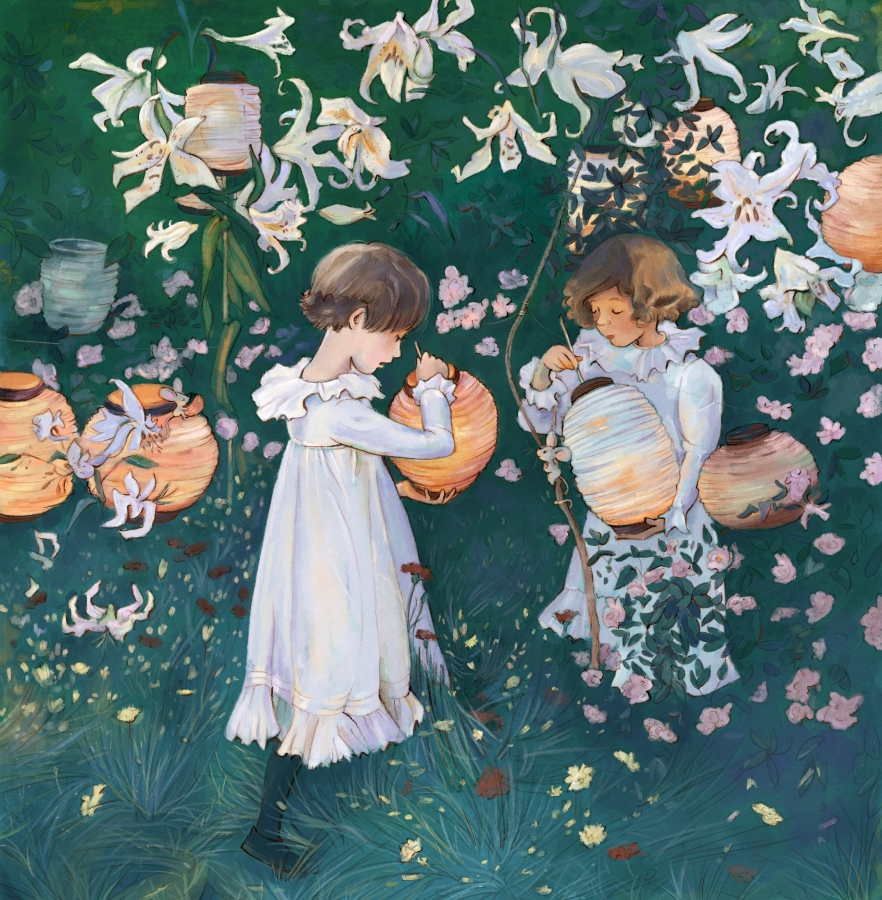

My Changes:
With the exception of adding in lines and some character stylization, I kept this pretty close to the original. (That original is so good—definitely one of my all-time favorites!) I also increased a tiny bit of color saturation.
Things I thought/Questions I asked:
This masterpiece is so magical! It takes me back to cool summer nights and magical twilight moments. I wish this was my garden flooded with flowers and glowing lights. How often did these sisters (Polly and Dolly) come out to enjoy Chinese lanterns? Did they light them often? Is this just for family pleasure, or are they getting ready for a party? What do Polly and Dolly usually do together? What do they talk about?
What I noticed or learned from Sargent’s techniques:
What isn’t there to love about this piece? I love Sargent’s graceful lines, his subject matter, the colors, the poses, the lighting. To achieve that lighting, he set up his subjects and props so he could paint 2-3 minutes daily under ideal lighting for more than a year. (Talk about dedication!) Although I don’t strive for realism, Sargent’s artistic sensibilities are in the vicinity of where I aim.
By the way, I didn’t expect to take so long perfecting the flowers. I guess that since I’ve drawn so many children it’s easier for me to draw them than inanimate objects. But—once again—this exercise reminds me that giving the background and supporting objects enough attention adds to the illustration as a whole.

My Changes:
I started out using most of the same colors from the original, but it just felt meh. So I played around with different colors and lightened the room as a whole. I also added a birthday cake. Whose birthday do you think it is?
Things I thought/Questions I asked:
Most families today have two or three children, so I love seeing all five here (though I made one of them perhaps a friend) and considering the things they are interested in. They look like they enjoy each other and that there’s a lot of laughter. I love that there’s a bit of clutter to help it feel lived in and to give us an idea about what they liked. Did they spend a lot of time in this room? Did they venture outside often? If they lived by the sea, I hope they did! Was their dad a sailor? Did they see him often, or was he away most of the time?
There are a few objects I’m not exactly sure about, like what is in the baskets on the floor? I think the left basket has shells (based on the nautical elements scattered throughout). And is the basket on the right a garden?
What I noticed or learned from Turner’s techniques:
I hadn’t seen this painting or heard of Edward Turner until researching potential MousterWorks. What drew me to it is its peek into what life was like for a family of lesser means—at least one not in nobility. Turner makes me want to know more about this family. Unfortunately, I couldn’t find any information about him or this painting. Although I ultimately decided to make it lighter, I do appreciate the mood he creates with the lighting.

When I was little, Mom and I often looked through a beautiful book of Masterpieces. I asked lots of questions about these people painted in time: How were we the same? How were we different? If you are also a fan of masterpieces, children’s book art, and searching for mice, I invite you to follow along!
All original images © Angela C. Hawkins


Love a MousterWork print? They will be available in my Etsy shop. Don’t see the one you want? Email me and I’ll add it in.